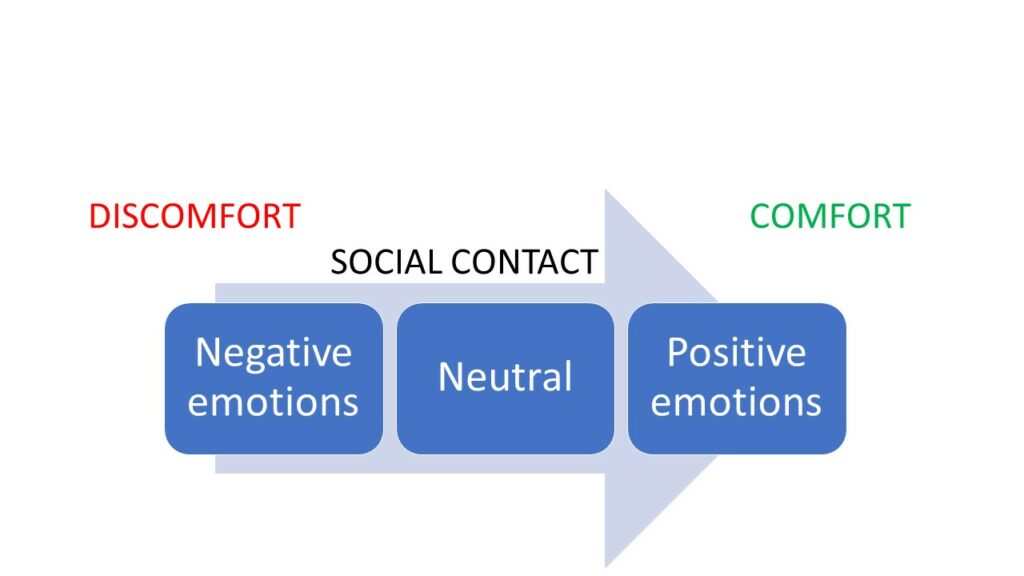Life is full of ups and downs. The ups are accompanied by positive emotions and the downs by negative emotions. Negative emotions bring discomfort and pain. The mind uses negative emotions to draw our attention to the pain.
One could, theoretically, listen to one’s negative emotions, work through them and find solutions to end the pain. However, under the grip of such emotions, most people find it hard to stay calm and think rationally.

When they’re experiencing a hard time, people seek an escape from their negative emotions. They achieve this via certain healthy and unhealthy coping mechanisms. One of the most effective and probably the healthiest coping mechanism is being comforted by social support.
We’re a social species, and regulating our negative emotions via social contact is a key feature of our psychology. It starts in infancy when a baby calms down upon being held by another human. The need for emotional regulation via social contact and support persists throughout adulthood.
This is why when we go through a rough time, we’re compelled to reach out to comforting people close to us.
In sum, comforting someone is the process of taking them from a negative emotional state to a positive or neutral state via social contact.

Comforting others is a skill
We all know that not all can comfort us equally. You probably don’t reach out to all your close friends for comfort. Some people seem to be better at comforting than others.
That said, most people simply aren’t good at comforting others. They don’t know how to react when their loved ones are going through a rough time. Worse, they sometimes end up making others feel worse with their insensitive statements.
If you’re a poor comforter, you can improve your skill of comforting others in no time. It’s all a matter of saying and doing the right things. You’ll say and do the right things when you gain a better and deeper understanding of the social dynamics involved.
Social dynamics of comforting others
We start by exploring the mental state of a person in discomfort. Those under the grip of negative emotions are prone to think irrationally. So, if you give them rational advice, don’t be surprised if they find it attacking, insensitive or irrelevant.
When you’re trying to comfort someone, it helps to think in terms of emotions. The other person is emotionally hurt and they need to heal, emotionally. They’re not seeking rational advice, instructions, or platitudes.
More often than not, the events that hurt people tend to be the ones that socially exclude them or have the potential to do so. Events such as:
- A breakup
- An argument
- Rebuke by someone in authority
- Making a mistake
- Depression
- Loss of a loved one
So, the logical question to ask yourself is:
“What can I say or do that will reverse the social exclusion?”
Or simply:
“What can I say or do that will make them feel included?”
Approaching the problem with this mindset will go a long way in helping you come up with tactics to comfort someone.
The second thing to keep in mind is that an emotionally hurt person tends to feel worthless. They feel vulnerable and their self-esteem takes a hit.
So, another way to comfort someone is to raise their self-worth.
While much emotional discomfort has a social cause, there are also non-social reasons that cause distress. For example, being stressed at work.
People who experience this type of discomfort are more receptive to rational solutions. Still, as a thumb rule, always try to satisfy the emotional need for comfort first before you move on to something rational.
Thus, social exclusion and a loss of self-esteem are the biggies of emotional discomfort. So, comforting someone is all about fixing these.
How to comfort someone
Before you learn how to comfort someone, it’s important to think about how close the other person is to you and the quality of your relationship. The closer you are to them, the more you can use the following comforting tactics liberally.
If you’re not that close and there isn’t enough trust in the relationship, you risk coming across as intrusive. As a rule, don’t comfort those who didn’t seek comfort from you.
1. Active listening
The first thing to do when someone comes to you with a problem is to just listen. It’s mind-boggling how people try to short-cut this. Be fully present and soak in everything they tell you.
“What happened?”
“Tell me everything.”
Active listening communicates:
“I’m here for you.”
“I’m willing to listen to you.”
It’s the easiest thing you can do to make them feel included.
2. Validation
Once you’ve listened to what they have to say; once they’ve verbalized their mental state, the next step is to validate them. Validating someone simply means acknowledging their thoughts and emotions.
Examples of validating statements:
“I’m sorry to hear that.”
“That must’ve been so hard on you.”
These statements acknowledge their mental and emotional state. Invalidating statements, on the other hand, try to dismiss or minimize their mental state. For example:
“You need to get over it.”
“It can’t be that bad.”
“You’re overreacting.”
Note that people who use invalidating statements are usually well-intentioned. But their statements backfire because they don’t realize they’re dismissing the other person’s mental state.
Researcher Dale Hample aptly called these anti-comforting messages. They communicate:
“I’m not engaging with your mental state.”
“I’m not engaging with you.”
Very excluding.
3. Empathizing
Your validation will be 100 times more effective if you can see things from their perspective. This is a skill that can take years to master.
Empathy works when you can relate to how they’re feeling- when you’ve also experienced something similar. For instance:
“I’ve been through a nasty breakup, too. It’s hell.”
Again, it communicates social inclusion:
“We’re in this together. We’re a team.”
4. Being non-judgmental
People often judge others negatively for feeling negative. This is a double whammy because not only are you invalidating them, you’re also attacking them. You’re sprinkling the salt of your negative judgments on their already bruised self-esteem.
“You’re so weak.”
“You need to be emotionally strong.”
“You’re stupid for having made such a silly mistake.”
By communicating that they’re worthless, you give them another reason to feel bad.
Conversely, by being non-judgmental, you allow their self-esteem to heal. They feel justified in feeling how they’re feeling.
5. Raising their self-esteem
You can go one step further from being non-judgmental to actually raising their self-worth. Focus their attention on their excellent qualities- praise and encourage them.
“You’re a resilient person. I strongly believe you can overcome this.”
Note that this shouldn’t be done at the cost of invalidating them. Don’t jump to telling them how special they are before you’ve taken the time to listen to them and validate them.
6. Comforting through physical contact
The simple acts of holding someone, resting your hand on their shoulder, or hugging them can be very comforting. Again, don’t do these things before you’ve validated their mental state or you come across like you’re providing ‘fake’ comfort.

7. Showing them you’re on their side
When people are hurt by others, their group psychology kicks in. They think of the person who hurt them as an outgroup and they recruit ingroup support. You are their ingroup support.
This is why saying bad things about the ‘outgroup’ can be very comforting.
“Yeah, your boss is a total jerk.”
8. Lowering yourself
Another excellent tactic that works on their loss of self-worth. When something bad happens to a person, they feel unworthy and lower than the average person.
If you lower yourself too, you reduce the gap and they don’t feel as bad about themselves.
For example, if they made a silly mistake, you can say:
“I once made the same mistake.”
“I’ve made ton of mistakes in my life.”
Not only does this communicate that it’s okay to make mistakes- a healthy mindset to have- but it also heals their self-esteem. They’re like:
“I’m not an unworthy person for making mistakes.”
9. Offering solutions at the right time
Once you’ve brought them to a neutral or positive emotional state from a negative one, it’s time to engage their rational brain.
But wait.
You need to be careful here too. Don’t shove advice down their throat. You need to approach their troubles with a mindset of:
“Let’s explore what’s going on. Maybe we’ll stumble on a solution along the way.”
It’s better to gently lead them to a solution than to throw it in their face. If you do the latter, they’ll feel you’re being dominating. They might disagree for the sake of disagreeing, to take back their power. Even if your solution is valid, they’ll resist it.
Offer your solutions without attacking or overpowering them. You need emotional intelligence to help them understand their emotions and come up with appropriate solutions.
